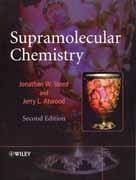David Smith reviews the second edition
Supramolecular chemistry (2nd edn)
Jonathan W. Steed and Jerry L. Atwood
Chichester: John Wiley 2009 | Pp990 | £45.00 | ISBN 978 0 47 051234 0

Over the past 40 years, supramolecular chemistry has become one of the most influential concepts in modern science. If atoms can be considered as individual letters, and molecules as words, then supramolecular chemistry considers how non-covalent interactions can link these molecular words together into sentences. By understanding the 'grammar' of non-covalent interactions, supramolecular chemists can generate receptors for target molecules, or assemble molecules into new nanoscale materials.
Supramolecular chemistry is an interdisciplinary science, with impact ranging from biology through to physics. Furthermore, it exemplifies key chemical principles - from intermolecular forces and thermodynamics, through synthesis, to spectroscopy - and is a great way of demonstrating these ideas in an interesting context to students.
This second edition of Supramolecular chemistry, achieves a difficult task - both capturing the excitement at the cutting-edge of this active research field, while also providing an in-depth educational introduction to the topic. It is a significant improvement over the first edition, broadening and updating the material, and introducing the application of the supramolecular approach to nanoscience.
The book begins with an overview of key principles and connects the topic to a biological context. The authors then consider how receptors can be developed for a wide range of target ions and molecules, before moving on to more complex multi-component self-assembled systems, and finally discuss devices, materials and applications.
The book is well presented, and well written in a clear didactic style. Each chapter has a useful bullet-point summary, and there are some study problems, which will help in course development. Unfortunately, to keep the price down, almost all of the standard figures are presented in greyscale - more use of colour would have significantly enhanced the impact and clarity of some of the figures.
Given its scope and importance, supramolecular chemistry is increasingly being embedded into degree-level education. This book should become required reading for students and teachers involved in such courses, particularly at higher levels of the degree. However, school teachers interested in the topic would be better off referring to Core concepts in supramolecular chemistry and nanochemistry (WileyBlackwell, 2007), which provides a bite-size introduction to the topic. Nonetheless, I would recommend this book for any university-level teacher interested in understanding what the 'buzz' is about supramolecular chemistry, and learning how it might connect with their own fields of interest.






No comments yet